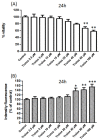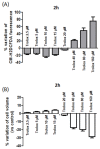Concentration Dependence of the Antioxidant and Prooxidant Activity of Trolox in HeLa Cells: Involvement in the Induction of Apoptotic Volume Decrease
- PMID: 33137938
- PMCID: PMC7693461
- DOI: 10.3390/antiox9111058
Concentration Dependence of the Antioxidant and Prooxidant Activity of Trolox in HeLa Cells: Involvement in the Induction of Apoptotic Volume Decrease
Abstract
Trolox (6-hydroxy-2,5,7,8-tetramethylchroman-2-carboxylic acid), a hydrophilic analog of vitamin E, is known for its strong antioxidant activity, being a high radical scavenger of peroxyl and alkoxyl radicals. Under particular conditions, Trolox may also exhibit prooxidant properties. The present work aimed at studying the dual antioxidant/prooxidant behavior of Trolox over a wide range of concentrations (from 2.5 to 160 µM) in HeLa cells. In particular, the study addressed the dose-dependent effects of Trolox on the oxidative cell status and vitality of HeLa cells, focusing on the potential role of the vitamin E analog in the induction of one of the first steps of the apoptotic process, Apoptotic Volume Decrease (AVD). In HeLa cells, Trolox showed significant antioxidant activity, expressed as the ability to reduce the endogenous ROS production detected by the ROS-sensitive probe 5-(and-6)-chloromethyl-2',7'-dichlorodihydrofluorescein diacetate (CM-H2DCFDA), at low concentrations (range: 2.5-15 µM), but exerted a dose-dependent prooxidant effect at higher concentrations after 24 h exposure. The prooxidant effect was paralleled by the reduction in cell viability due to the induction of the apoptotic process. The dual behavior, antioxidant at lower concentrations and prooxidant at higher concentrations, was evident also earlier after 2 h incubation, and it was paralleled by the isotonic shrinkage of the cells, ascribed to AVD. The use of SITS, known Cl- channel blocker, was able to completely inhibit the Trolox-induced isotonic cell shrinkage, demonstrating the involvement of the vitamin E analog in the alteration of cell volume homeostasis and, in turn, in the AVD induction. In conclusion, the study shed light on the concentration dependence of the Trolox antioxidant/prooxidant activity in HeLa cells and revealed its role in the induction of one of the first events of apoptosis, AVD, at high concentrations.
Keywords: AVD; HeLa; Trolox; antioxidant; apoptosis; prooxidant.
Conflict of interest statement
The authors declared that there are no conflict of interest.
Figures





Similar articles
-
Fibrinogen is a co-antioxidant that supplements the vitamin E analog trolox in a model system.Free Radic Res. 2006 Mar;40(3):321-31. doi: 10.1080/10715760500488998. Free Radic Res. 2006. PMID: 16484048
-
Apoptotic volume decrease (AVD) in A549 cells exposed to water-soluble fraction of particulate matter (PM10).Front Physiol. 2023 Jul 10;14:1218687. doi: 10.3389/fphys.2023.1218687. eCollection 2023. Front Physiol. 2023. PMID: 37492639 Free PMC article.
-
Prooxidant and antioxidant properties of Trolox C, analogue of vitamin E, in oxidation of low-density lipoprotein.Free Radic Res. 1999 Mar;30(3):181-8. doi: 10.1080/10715769900300201. Free Radic Res. 1999. PMID: 10711788
-
An in vitro study on the free radical scavenging capacity of ergothioneine: comparison with reduced glutathione, uric acid and trolox.Biomed Pharmacother. 2006 Sep;60(8):453-7. doi: 10.1016/j.biopha.2006.07.015. Epub 2006 Aug 14. Biomed Pharmacother. 2006. PMID: 16930933
-
Apoptosis, cell volume regulation and volume-regulatory chloride channels.Comp Biochem Physiol A Mol Integr Physiol. 2001 Oct;130(3):377-83. doi: 10.1016/s1095-6433(01)00424-x. Comp Biochem Physiol A Mol Integr Physiol. 2001. PMID: 11913451 Review.
Cited by
-
Cellular Oxidative Stress.Antioxidants (Basel). 2021 Mar 6;10(3):399. doi: 10.3390/antiox10030399. Antioxidants (Basel). 2021. PMID: 33800761 Free PMC article.
-
Shedding Light on the Hidden Benefit of Porphyridium cruentum Culture.Antioxidants (Basel). 2023 Jan 31;12(2):337. doi: 10.3390/antiox12020337. Antioxidants (Basel). 2023. PMID: 36829897 Free PMC article.
-
Apigenin's Modulation of Doxorubicin Efficacy in Breast Cancer.Molecules. 2024 Jun 1;29(11):2603. doi: 10.3390/molecules29112603. Molecules. 2024. PMID: 38893482 Free PMC article.
-
Intracellular Redox Behavior of Quercetin and Resveratrol Singly and in Mixtures.Molecules. 2023 Jun 9;28(12):4682. doi: 10.3390/molecules28124682. Molecules. 2023. PMID: 37375237 Free PMC article.
-
Plant-Origin Stabilizer as an Alternative of Natural Additive to Polymers Used in Packaging Materials.Int J Mol Sci. 2021 Apr 13;22(8):4012. doi: 10.3390/ijms22084012. Int J Mol Sci. 2021. PMID: 33924597 Free PMC article.
References
-
- Lúcio M., Nunes C., Gaspar D., Ferreira H., Lima J.L.F.C., Reis S. Antioxidant Activity of Vitamin E and Trolox: Understanding of the factors that govern lipid peroxidation studies in vitro. Food Biophys. 2009;4:312–320. doi: 10.1007/s11483-009-9129-4. - DOI
LinkOut - more resources
Full Text Sources

